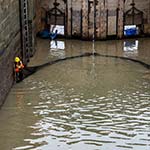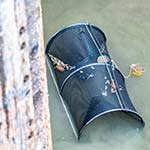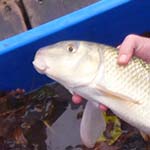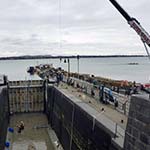
Fish Rescue
Chambly Canal National Historic Site
At the end of every navigation season, the water level in the Canal is lowered so our staff can carry out essential maintenance to keep the locks in good working order. The water is gradually lowered using valves through which the fish in the Canal find their way toward the nearest body of water. However, even though most of the fish get out of the Canal, sometimes several of them get trapped in residual pools. When work needs to be done in these areas, human intervention is required to allow them to return to the river. This is what happened in Chambly!
Complete drying and rehabilitation of locks
Two exercises to rescue and relocate fish trapped in residual pools during the drying of the chambers of Locks Nos. 1, 2, 3 and 9 were carried out this fall. Before lowering the water level, Parks Canada made sure that the fish trapped in pools were collected, identified and relocated to the the Richelieu River where the conditions were favourable for their survival and free movement, while reducing the stress and harm to them.
Fish recrue at Chambly Canal
Transcript
Parks Canada logo
Close up (CU) of an employee attaching a metal clip to his safety harness
Today we are rescuing and moving fish from lock 6 of the Chambly Canal.
Panning shot of the site next to the lock, a group of people are talking/meeting
Medium Shot (MS) shot of Parks Canada employee speaking
Interventions such as this one are very important to the repair work at the locks.
MLS of Parks Canad employee talking with the lock in the background behind her - Text Graphic appears " Karine Lalonde; Environmental assessment agent, Parks Canada"
This is part of the environmental mitigation measures that are being put in place ...
Crane being backed-up
to complete the work with minimal impact on the environment.
Long shot of employees observing the crane being set in place
Shot of two books laying in the grass (The book is on fish)
Long shot of an employee climbing down the ladder into the lock
The majority of fish succeeded in leaving the lock when the canal was lowered.
Medium Shot (MS) shot of Parks Canada employee speaking
There are approximately one to two feet of water remaining, and there are fish in the lock bottom.
Shot of container being lowered into the lock
High angled shot of a worker pulling out a bin from the container
To move the fish, COVABAR was called in [committee for consultation on and development of the Richelieu River basin]
High angeled shot of worker taking out a net
Long shot (LS) of the worker moving the net around the lock
They descended to the lock bottom, they used a large stage, they also have dip nets to retrieve the fish.
MCU of employee pulling on the net
Above shot on the net moving through the water in the lock - moving left to right
Close up of the water collected being filtered, through to use of a fish net
Shot of employee pick out each fish by hand and placing them inside a bin
Long shot (LS) of 2 employees looking inside of the bin from the container, with the locks walls as the background
The fish are put in bins, and the bins are brought back up using a boom truck.
MS of two employees pulling out fish from the net and palcing them in the bins
Another shot of the same action (placing fish into the bins)
Close up of employee closing the bin
Shot of container being lifted out of the lock
Shot of container being replaced on the ground outside of the lock
The bin of fish that were retrieved from the lock was just put in a truck
MCU of Karine is sitting in the drivers seat, talking to us
...that is now on the way to the Chambly Basin where the fish will be released.
Shot of pick-up truck driving away
Shot of the lake
High angled shot of Parks employees pourring out the bin into the lake
Go Pro shot underwater of a fish swimming
"Shot of fish moving around in the water. Text appears ""2,652 fish identified in locks 6 and 7 21 species observed and relocated""
"Visit Parks Canada's website to learn more about the fauna of the Chambly Canal.
Parks Canada
"Her Majesty the Queen in Right of Canada represented by Parks Canada, 2017
"Logo of Canada
How do we move the fish?
Parks Canada approached COVABAR, the Comité de concertation et de valorisation du bassin de la rivière Richelieu, to rescue the fish. This teamwork allowed for the effective tracking of the species that were picked up and relocated.
A team from COVABAR descended into the locks and picked up the fish using a platform and nets. The fish that were collected and identified were placed in containers, which were then removed from the locks with a boom truck.
More then 50 000 fish from 21 different species were identified and relocated. Among these species were yellow perch, smallmouth bass and pumpkinseed. One copper redhorse, a species designated “threatened” under the Government of Quebec’s Act respecting threatened or vulnerable species and “endangered” under the Government of Canada’s Species at Risk Act, was also observed. However, handling the fish to confirm the good news could have endangered its life.
Quick intervention
The success of the operation depended largely on how quickly the teams in the field could work. The primary focus was therefore on the rapid release of the individuals into the river. In addition, the bins were not emptied directly into the basin, but rather were gently submerged. This reduces stress and shock, which could lead to fish mortalities. After being submerged, the weakest individuals were reoxygenated. This technique consisted of holding the fish and moving it back and forth in the water until it regained strength.
Water oxygen
One of the factors that was most closely monitored during the operation was the oxygen concentration in the water, particularly in Lock No. 1 because a large number of fish had been detected there during previous inspections. The experts on site made considerable efforts to record the oxygen meter readings to ensure that the oxygen concentration did not fall below a critical level, in which case the emergency procedure would have had to be deployed.
This initiative is part of the environmental mitigation measures that Parks Canada is putting in place when working.
Photo gallery
- Date modified :




